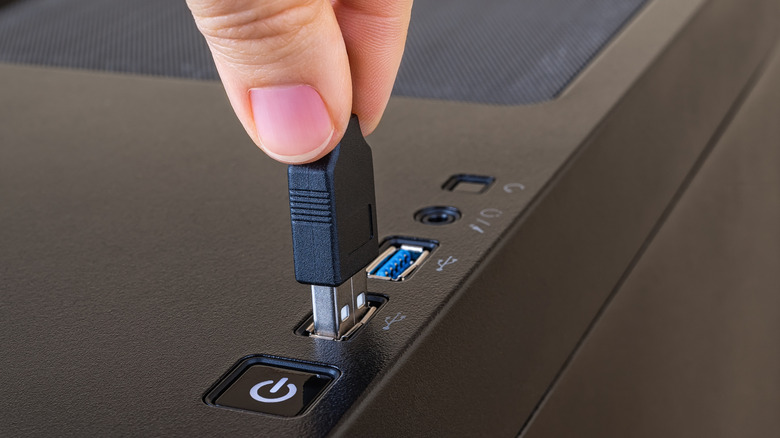Why Are Some USB Ports Blue? Here's What It Means
Whether it's the laptop you use for work or your future-proof gaming PC, looking at a row of USB ports — some black, some blue, and even other colors — can be overwhelming. While the colors may differ, the ports generally look the same, making it hard to distinguish one from the other. You may have wondered if those bright blue ports we commonly see on computers meant anything special or if manufacturers just added them to make things look a little bit cooler. After all, you usually won't find an instruction booklet explaining what the different colors mean when you buy a new PC. So you're left to guess what they might mean or whip out your computer to find information about them online.
While those colors staring back at you from those USB ports may seem insignificant, knowing what they mean can help you get the most out of your devices. USB ports come in so many different colors because not all USB ports are created equal. Each color acts as a visual representation of a specific USB standard or feature, giving users an idea of things like its data transfer speeds and power output capabilities. The blue ports come in two variations: classic blue and teal blue. What's important to know is that USB ports have sped up over time, and when you see a blue port, it's typically a high-speed port, such as USB 3.0 or USB 3.1 Gen 1, which is much faster than older standards like USB 2.0.
What does a blue USB port mean?
If you've ever questioned the difference between USB 2.0 and USB 3.0 and how to tell them apart, an important clue can be found in the color of the port. When you see a USB port with classic blue coloring, you'll quickly know it's a USB 3.0 port, whereas USB 2.0 ports are black. These blue ports, also known as SuperSpeed USB, made their debut back in 2008 and boast much faster speeds than their predecessors, maxing out at 5Gps, compared to the USB 2.0's 480 Mbps. That means blue USB ports are up to 10 times faster than their black counterparts.
Blue USB ports support full duplex communication, meaning they can transfer data in both directions at the same time. For example, if you're transferring files from an external hard drive to your computer, the drive can simultaneously receive new commands without interrupting the transfer. In contrast, with USB 2.0, data can only flow in one direction at a time. While blue USB ports are faster and more advanced, they're backward compatible, so you can use them with older USB 2.0 devices.
As you're exploring the USB ports on your PC tower or other device, you may also come across light blue or teal ports. These are USB 3.1 Gen 1, also known as SuperSeed+ ports, and they reach speeds up to 10Gbps — twice as fast as the classic blue USB 3.0 ports. Their fast speeds make them a great choice for use with a USB dock or for devices that need to transfer large amounts of data quickly.

